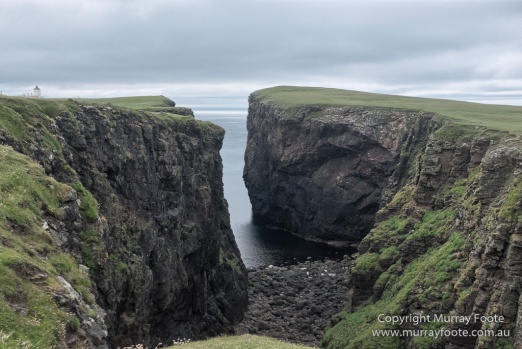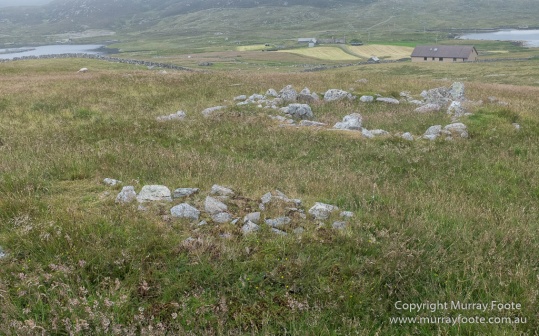Shetland, Scotland. Day 28, 26th July.
From Scalloway Castle and West Burra I headed to Northmavine, the wild top corner of Mainland on Orkney. Due to the weather and shortness of time I didn’t see many of the places I had identified as worth visiting. It’s the sort of place that would repay long walks and much time spent in different weather conditions. That wasn’t available to me but much of what I saw was nonetheless impressive.
.
 This is Dore Holm, or the Drinking Horse.
This is Dore Holm, or the Drinking Horse.
This is Calder’s Geo at Esher Ness in Northmavine. A sea cave on the northern side (here the right hand side) is the largest in Britain, 20 metres high and with a floor area of 5,500 square metres (or about eight football pitches). The cave is accessible from the sea and only when it is calm. There are also not too many boats in the near vicinity.
The lighthouse was designed by David Stevenson It is the last built by the Stevenson family and first lit in 1929.
Another coastal view nearby, at Esher Ness.
The stacks on the horizon are The Drongs. We are now driving away from Esher Ness.
A dry stone farm building at the end of a remote road. Perhaps this was once a family house.
Back in West Mainland, near where I was saying, this is the Scord of Brouster. Here we see one of the neolithic farm buildings. It was farmed from 3000BC to 1500BC. In 1500BC a climatic change brought wetter and colder weather and because all the trees had been chopped down for land clearing, building or fuel, the fertile soil changed to peat and the land was never farmed again. This is why we can see these ancient remains today.
This is a cairn. I presume that means a funeral cairn but I don’t know. There are three houses and one also has a workshop or outhouse.
.
Another of the houses. The earliest houses were made of wood and no trace of them is visible. There are also some remains of field walls. The farmers grew an early form of barley and ploughed their fields with wooden ploughs or ards, pulled by oxen. The ploughs had stone tips which broke when they hit rocks under the ground. Seventy-five of these ard tips were found on site. Fragments of pottery, steatite (soft stone) bowls and handled clubs were also found.
Australian readers are free to speculate that the Scord of Brouster may have been the home of the ancestors of the Brewster Brothers.
Close to where I was staying at Burrastow, here are a couple of abandoned croft houses beside the road.









The drinking horse a really interesting motive! Thanks for sharing these amazing pictures!
LikeLiked by 1 person
Thanks very much Moritz!
LikeLiked by 1 person
Amazing!! Such beautiful scenery!
LikeLike
Very special places. There was also a lot more I didn’t get to.
LikeLike
The first five definitely deserve to be treated to your monochorme processing, Murray. Great!
LikeLike
Thanks very much Alessandro! I’ll have another post in a little while for mono versions from Shetland and Aberdeen.
LikeLike
Pingback: Journey to North Atlantic – Itinerary and Index of Posts « Murray Foote
From one who worked with race horses all my life, I love this shot!
Thank You
LikeLike
Thank you. Wonderful place, Shetland. I also notice your association with Blues. I am taking photographs at Narooma Blues Festival as official photographer next weekend and we will be in New Orleans for 10 day in early November.
LikeLike
Lucky You!
Yes my fav. genre, so enjoy some for me. When I think of N.O. for some reason I always think of Professor Longhair’s “Her Mind Is Gone”. LOL
It just defines the sound. I will look forward to those pic’s.
LikeLike
Pingback: Monochromes from Shetland and Dunnottar Castle « Murray Foote